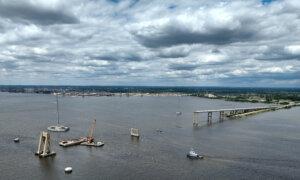Emergency funding request would boost federal highway disaster relief program by $3.1 billion and fully fund the Francis Scott Key Bridge rebuild.
The Biden administration, on June 28, submitted a $4 billion emergency funding request to Congress, which includes $3.1 billion for a federal highway disaster relief program to fully pay for rebuilding the Francis Scott Key Bridge, and more than $725 million to boost federal disaster responses to the 2023 Maui wildfire and tornado recoveries in Iowa, Nebraska, and Oklahoma.
Biden administration officials, speaking before the request was formally filed in a letter from the director of the Office of Management and Budget, Shalanda Young, to House Speaker Mike Johnson (R-La.), called the request “a refresh” of the president’s October 2023 $106 billion emergency funding package.
Congress in April adopted a $95 billion supplemental funding package that included $60 billion for Ukraine and $14.1 billion for Israel.
The $4 billion emergency request addresses the “urgent requests the President put forward last October that would bolster border security and address urgent domestic needs, including disaster relief,” Ms. Young wrote in her letter to Mr. Johnson.
The emergency disaster funding request comes as the National Oceanic and Atmospheric Administration (NOAA) is projecting an “extraordinary” hurricane season in the coming months, she noted.
“The administration urges prompt congressional action on this request, including for the Federal Emergency Management Agency’s (FEMA) Disaster Relief Fund (DRF), to ensure that we can uphold the federal government’s responsibility to both rebuild from past disasters and respond to future events,” Ms. Young wrote.
The bulk of the supplemental package—$3.1 billion— would be directed into the Department of Transportation’s Emergency Relief Program (DOT-ER) to “cover increased needs for repairing and rebuilding highways and roads that have been damaged in disasters and other emergencies across the Nation, including the cost of rebuilding the Francis Scott Key Bridge in Baltimore,” she said.
The 47-year-old, 1.6-mile Francis Scott Key Bridge was knocked down by the 95,000-ton, Singapore-flagged containership Dali on March 26, killing six construction workers and shutting down the Port of Baltimore for weeks.
Under the FHWA’s emergency program, the federal government reimburses states at 100 percent for the first 270 days after approving an emergency application. After that, states get reimbursed at 80 to 90 percent.
As part of the proposal, the FHWA approved Maryland’s request to designate the Key Bridge as part of the interstate system, changing its Maryland State Route 695 designation to I-695 to qualify for 90 percent reimbursement rather than 80 percent as a state highway.
House Republicans in April and May hearings shot down the BRIDGE Act partly because Maryland lawmakers and state transportation officials had not nailed down a cost estimate for rebuilding the bridge. Approving an open-ended commitment without a clear idea of the total cost was premature, they said.
Republicans also maintained that a cost-share is unnecessary because the Federal Highway Administration’s emergency relief program already allows for a 100 percent federal cost-share for the first 270 days after a disaster.
The Biden administration and Maryland officials argued that the 100 percent cost-share during the first 270 days wouldn’t cover rebuilding costs. They said the emergency funding measure would provide certainty in proceeding with the bridge replacement.
The Maryland Transportation Authority (MDTA) estimated in May that it would cost $1.7 to $1.9 billion to rebuild the bridge. The bid deadline for design-build proposals was June 24, and the agency aims to award the contract this summer and have a new structure in place by mid-October 2028.
The ship crash closed much of Baltimore Harbor to commercial shipping traffic for weeks. On June 10, the full 700-foot-wide main shipping channel was fully cleared.
The Dali itself only left the harbor on June 24 to travel 170 miles to Norfolk, Va., where it will undergo continued repairs. The departure followed the completion of the National Transportation Safety Board’s (NTSB) examination of engineering systems and electrical system testing, as well as interviews with the crew.
In addition to $3.1 billion for FHWA, the proposed request includes $33 million for the U.S. Army Corps of Engineers to replenish funds used for wreckage removal in Baltimore Harbor and $79.5 million for the Coast Guard’s response to the disaster.
A $25 million allocation to the Dislocated Worker National Reserve would address manpower and contractor needs generated by “multiple large disasters, including typhoons, wildfires, and hurricanes, as well as cleanup and recovery efforts” in Baltimore Harbor.
The administration’s finding request seeks $700 million for the Department of Housing and Urban Development Department “to address disaster relief, long-term recovery, and mitigation in the most impacted and distressed areas resulting from major disasters occurring in 2023 and future years.
“The Administration is also reiterating the need for action on other items in the October supplemental requests, including for the DRF, child care stabilization funding, wildland firefighter pay, and the Federal Communications Commission’s Affordable Connectivity Program,” Ms. Young wrote.
An administration official told reporters in the background briefing that there is no deadline for congressional leaders to respond but “obviously, these are urgent needs that, in many cases… we’ve been requesting now for almost nine months. So, I think our desire is that Congress acts as swiftly as possible.”
Original News Source Link – Epoch Times
Running For Office? Conservative Campaign Consulting – Election Day Strategies!


